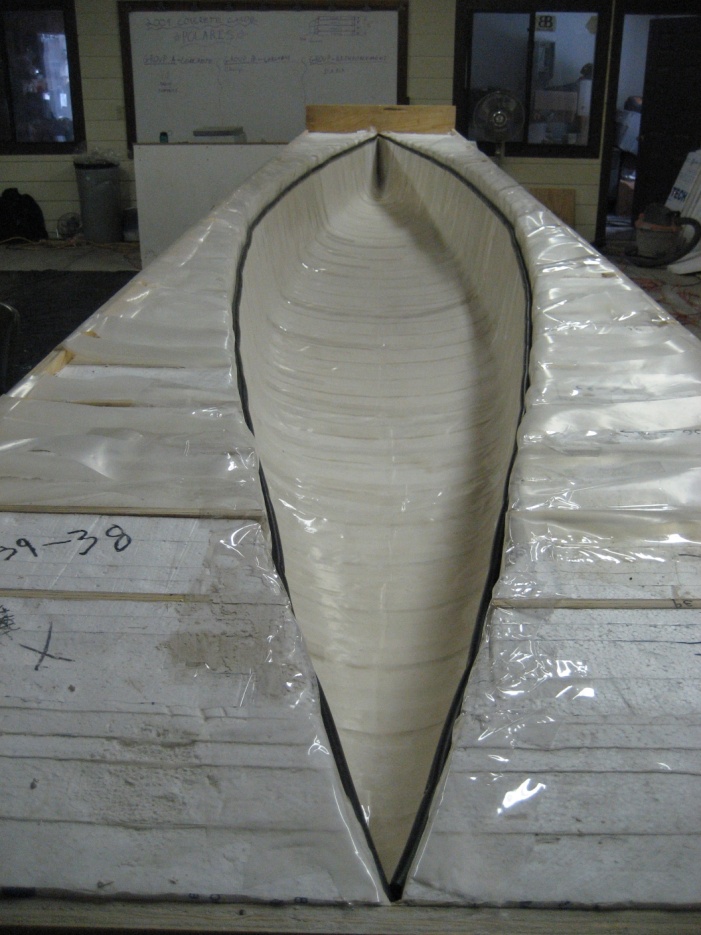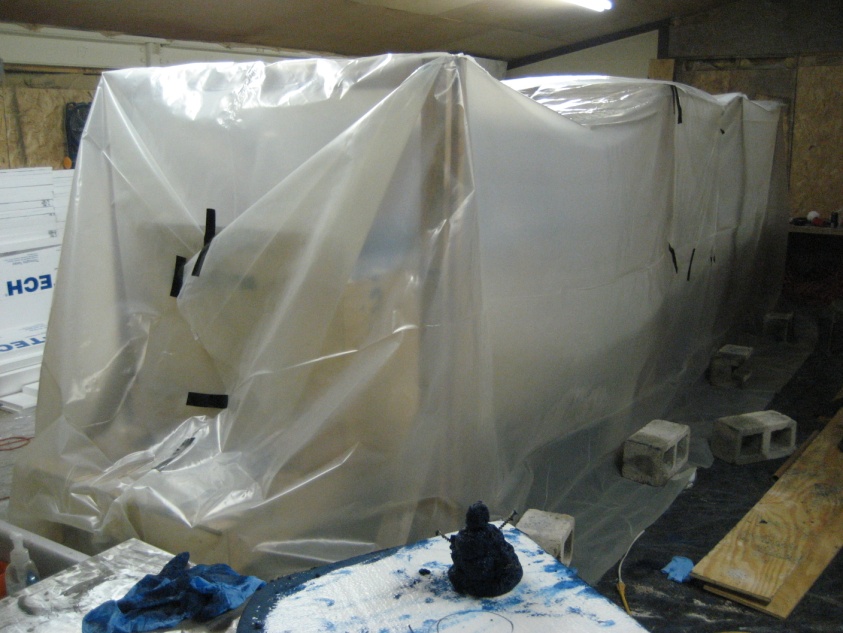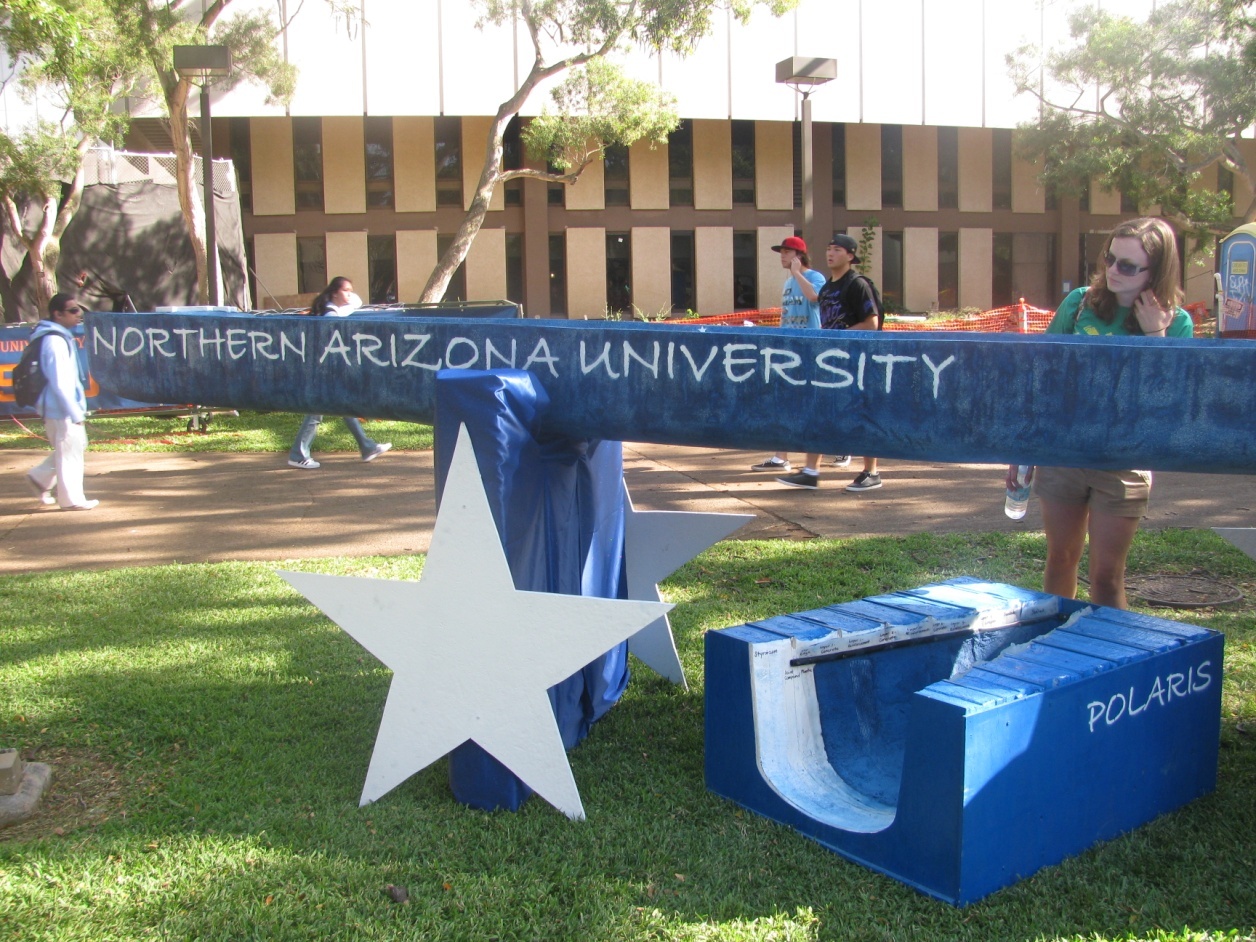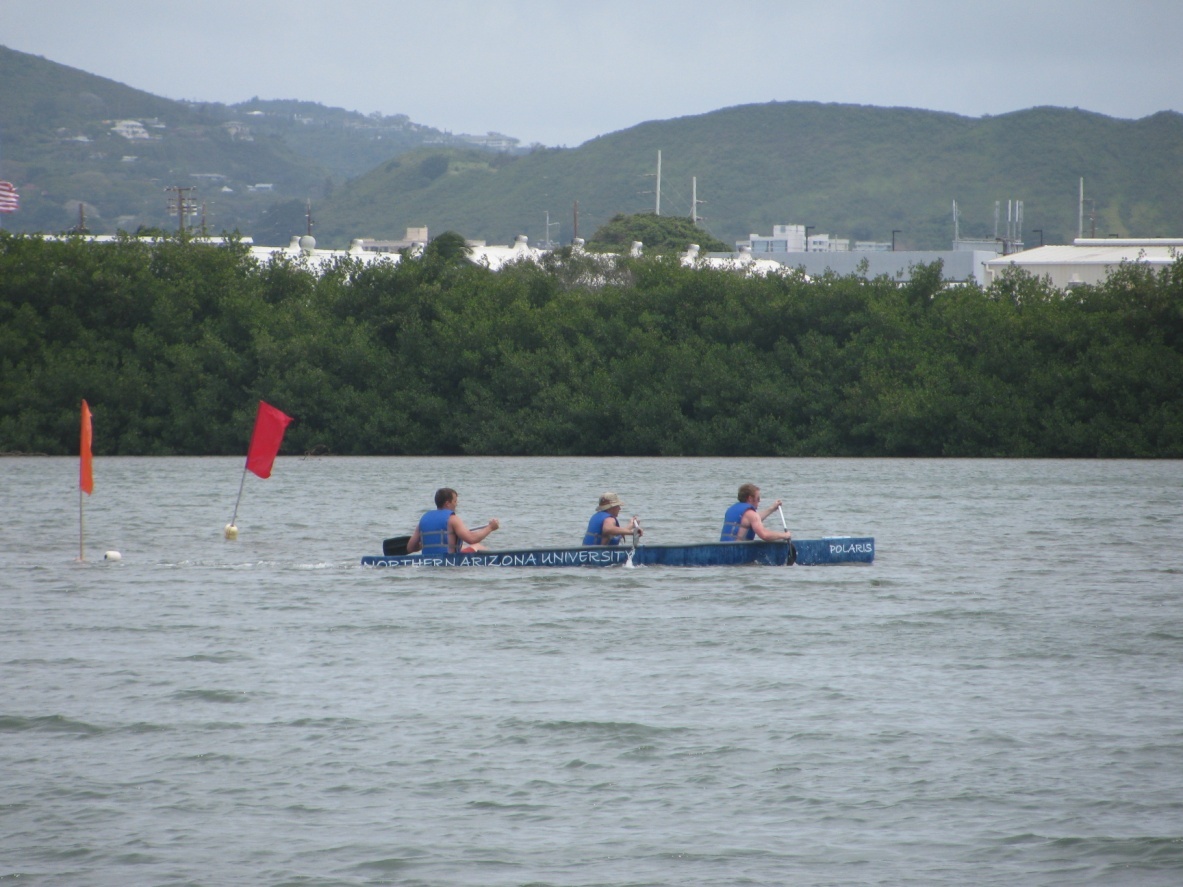

2009 NAU ASCE
Concrete Canoe
Ashley Bibeau,
Steven Rowson, Vanessa Smith & Tauras Stockus
Department
of Civil and
Environmental Engineering,
Northern Arizona University,
Flagstaff, AZ 86011

Analysis &
Design

Conference Performance

Acknowledgements

Conclusion

Abstract
Purpose: To design, build
and compete a concrete canoe for competition in the annual ASCE Pacific
Southwest Regional Conference (PSWRC).
The 2009 NAU ASCE Concrete Canoe, named
Polaris, implemented innovative design and construction throughout the
project. The goal for this year was to create a canoe with an improved design
and construction techniques that could be used and built upon in the future.
Documentation for future concrete canoe teams at NAU will be left so that
teams will have reference of processes used and lessons learned. The design
team began its work in July 2008 in order to accommodate the strict
requirements for the canoe. Some of
these requirements included the outer dimensions of the hull and 25% recycled
material in the concrete mix aggregate.
In order to achieve the specific dimensions, Polaris utilized a female
mold. The mold was created using wood cross sections and Styrofoam. Polaris’ final design used concrete that was
lighter and stronger than past year’s designs. 25% of the overall aggregate in
the mix consisted of cenospheres as the required recycled material. The
reinforcement consisted of fiberglass mesh and was placed in three layers to
resist the stresses calculated in the structural analysis. The canoe, once
completed, was shipped to Hawaii to compete in the 2009 Pacific Southwest
Regional Conference.
The design of Polaris was completed in several phases. First, the team used Prolines, a hydraulic
analysis software, to determine hydrostatics on the hull. Various load cases were analyzed in Prolines
which allowed us to determine waterline elevations, brake horsepowers, etc.
SAP2000 utilized this information to provide a structural analysis of the
canoe. Different boundary conditions
were combined with the worst case loading from Prolines of 1,000lbs to view
stresses throughout the hull. These
values allowed us to determine the strengths needed from both the concrete mix
and reinforcement, as well as rib placement throughout the canoe.
The primary goal for the concrete mix this year was strength. We wanted to provide a concrete mix that
could withstand the calculated stresses and stresses due to shipment. We also wanted to create the lightest mix
possible. A total of 14 mixes were
created and the top mix was chosen based on its 28 day strength. This year, we
were required to incorporate 25% recycled aggregate into our mix and decided
to utilize cenospheres, a byproduct of coal combustion, to meet this
requirement.
The reinforcement design for Polaris was very different this
year. We utilized a reinforcement
scheme which included fiberglass mesh in three layers throughout the
canoe. The ultimate tensile strength of
our reinforcement was 201lbs/in and had 55% open area to meet minimum open
area requirement.


Construction
The construction of Polaris required engineering of both the mold and
processes during construction of the canoe itself. In order to abide by the strict dimensional
guidelines, Polaris implemented a female mold.
A significant amount of thought and design went into the preparation
and construction of the mold. The mold
was engineered using plywood cross sections and Styrofoam. The completed sections were placed together
and aligned along the starboard side of the canoe. Once the canoe was completely aligned and
all of the plywood sections were screwed in, the Styrofoam and wood sections
were sanded down. Joint compound was
then used to fill in and smooth out any imperfections. The joint compound was sanded down after
about 24-48 hours and plastic strips were placed inside the mold as a bond
release mechanism.
Once the mold was completed, the canoe was ready to be poured. Four layers of concrete were placed during
construction of the canoe. Each layer
was approximately 1/8” thick. This
thickness was checked with T-pins which were marked with different
measurements on it. A layer of
fiberglass mesh was placed between each layer of concrete. In order to prevent the second layer of
reinforcement from being placed on the neutral axis at ¼”, the second layer of
concrete was poured slightly thicker than 1/8”. Once the hull was completed, four ribs were
placed within the canoe. The team
utilized wooden star cutouts in order to form areas for future inlays. These cutouts were placed in various
locations and included the big dipper pointing to the North Star. These cutouts were removed after about seven
days and filled in. End caps were then
formed using some of the male mold Styrofoam sections. Concrete was then laid over the top and
sides of the end caps and the pop-out sections were placed.
Once the canoe pour was completed, the curing tent was set up. Humidifier and heaters were used to keep the
canoe at the proper moisture and temperature settings. After the canoe had cured for seven days,
the inside was sanded and patched. The
same was done for the outside after complete curing had occurred. Final sanding, staining of the inlays, lettering
and sealing was then completed.
After ten months
of hard work, NAU-ASCE is proud of the final design and construction of
Polaris. Many hours of design, testing
and construction went into this project with a very successful outcome. This years’ design team hopes to be an
inspiration for years to come.
Our team spent a
lot of effort and put forth a lot of dedication throughout the course of this
project. We went above and beyond our
ideas of innovation to achieve a successful product. We implemented the use of a female mold,
which had never been done before.
Countless hours of preparation went into preparing the canoe for pour
day. We tested many different concrete
mixes to find the best one possible.
Our reinforcement design is the best design NAU has put forth in a very
long time. The use of SAP2000 in
helping us determine key locations for stresses throughout the canoe was
extremely beneficial for the concrete mix design and testing as well as
reinforcement design and layout. By
having strong project management, we were able to stay on task and accomplish
major deadlines. This year has been a
huge success for the concrete canoe at NAU and we are very proud of our fourth
place finish.

EGR Design

References




The Pacific Southwest Regional Conference was held at the University
of Hawaii at Manoa April 2nd – 4th 2009. 17 different schools from Southern
California, Nevada, Arizona and Hawaii participate in this conference. The concrete canoe competition is one of the
biggest competitions at conference and included several days’ worth of
judging. Four different aspects of the canoe were judged
to determine overall placement. These
included final product, a design paper, an oral presentation and races.
The team spent many hours working on each of these four aspects. Overall , we performed very well at
conference and our hard work paid off.
The following table depicts the score for each aspect of judging , as
well as our overall score.
By winning fourth place at this years’ conference, w e have
successfully put NAU back into competition with leading engineering schools in
our conference. Because of our hard
work and dedication throughout the entirety of the project, we were able to
provide our student chapter of ASCE with a canoe that it can build upon for
the future and be proud of for many years to come. It is our hope upon completion of this
project that future concrete canoe teams can continue this winning tradition
and advance to the national competition.



ASTM
(2007). “Standard Test Method for Compressive Strength of Cylindrical Concrete
Specimens.” C39-05, West Conshokocken, PA.
ASTM
(2007). “Flexural Strength of Concrete (Using Simple Beam with Third-Point
Loading).” C78-07, West Conshokocken, PA.
ASTM
(2007). “Standard Test Method for Density, Relative Density (Specific
Gravity), and Absorption of Coarse Aggregate.” C127-07, West Conshokocken,
PA.
ASTM
(2007). “Standard Test Method for Density, Relative Density (Specific
Gravity), and Absorption of Fine Aggregate.” C128-07, West Conshokocken,
PA.
ASTM
(2007). “Standard Test Method for Sieve Analysis of Fine and Coarse
Aggregates.” C136-06, West Conshokocken, PA.
ASTM
(2007). “Standard Test Method for Density (Unit Weight), Yield, and Air
Content (Gravimetric) of Concrete.” C138/C138M, West Conshokocken, PA.
ASTM
(2007). “Standard Test Method for Slump of Hydraulic Cement Concrete.”
C143-05a, West Conshokocken, PA.
ASTM (2007). “Standard
Test Method for Density of Hydraulic Cement.” C188-95, West Conshokocken,
PA.